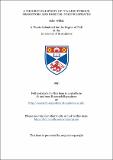Files in this item
A theoretical study of TPA-like tumour promotors and inositol polyphosphates
Item metadata
| dc.contributor.advisor | Thomson, Colin | |
| dc.contributor.author | Wilkie, John | |
| dc.coverage.spatial | 262 p. | en_US |
| dc.date.accessioned | 2018-06-15T12:54:48Z | |
| dc.date.available | 2018-06-15T12:54:48Z | |
| dc.date.issued | 1991 | |
| dc.identifier.uri | https://hdl.handle.net/10023/14120 | |
| dc.description.abstract | In this thesis, the structures and selected properties of TPA-like tumour promoters and of Myo-inositol polyphosphates are calculated and compared with their promoting and calcium releasing activities respectively. Three different levels of theory are used in the calculations, namely ab initio, semi empirical and molecular mechanics, though the majority of the calculations are performed using the MNDO derived semi-empirical methods implemented in MOPAC. A detailed description of the phorbol ester / DAG binding site is obtained from the structure / activity relationships derived for the tumour promoters and molecular dynamics simulations of the phorbol ester, TPA, in a lipid bilayer is carried out to investigate the position of the binding groups in relation to the surface of the bilayer. In order to carry out this simulation, a method (HYDRO) has been developed to produce close packed heterogeneous bilayers in which the headgroups of the components lie in random orientations. Thus the simulations are more realistic than calculations in which the lipids are placed in a regular array and interstitial spaces due to the difference in surface area of the bilayer components are kept to a minimum. The effects of the number and position of phosphate groups on the ring conformations of myo -inositol phosphates and the connection between this and calcium releasing activity are studied in chapter 5. As the molecules are particularly flexible with a large number of potential local minima, phosphate groups have been added sequentially to keep the required number of starting points as low as possible and rotation of phosphate hydroxyls has been ignored. The heats of formation, calculated with the different semi-empirical parametrisations, differ considerably, so the final calculations chapter compares energies and selected properties calculated for model organics phosphates using different methods and theory. The results using the new parametrisation, PM3, are compared with those of the earlier AMI for both the phorbol systems and the inositol phosphates to test its suitability. | en_US |
| dc.language.iso | en | en_US |
| dc.publisher | University of St Andrews | |
| dc.subject.lcc | QH659.W5 | en |
| dc.subject.lcsh | Cells | en |
| dc.title | A theoretical study of TPA-like tumour promotors and inositol polyphosphates | en_US |
| dc.type | Thesis | en_US |
| dc.type.qualificationlevel | Doctoral | en_US |
| dc.type.qualificationname | PhD Doctor of Philosophy | en_US |
| dc.publisher.institution | The University of St Andrews | en_US |
This item appears in the following Collection(s)
Items in the St Andrews Research Repository are protected by copyright, with all rights reserved, unless otherwise indicated.

